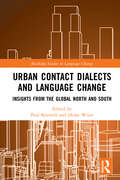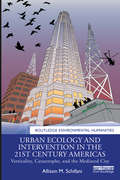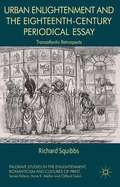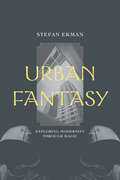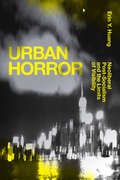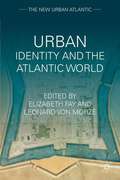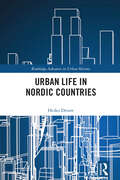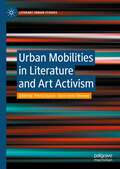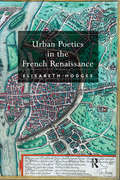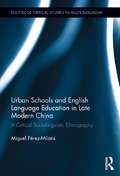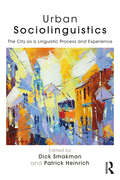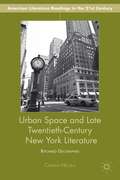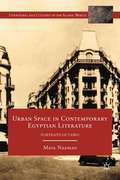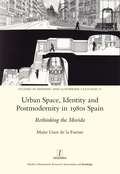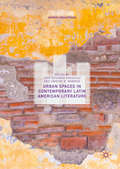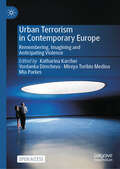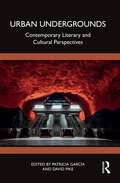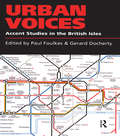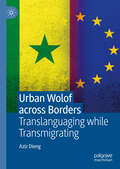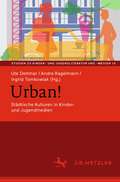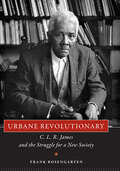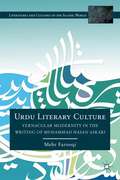- Table View
- List View
Urban Confrontations in Literature and Social Science, 1848-2001: European Contexts, American Evolutions
by Edward J. AhearnIn an innovative contribution to the challenging of disciplinary boundaries, Edward J. Ahearn juxtaposes works of literature with the writings of social scientists to discover how together they illuminate city life in ways that neither can accomplish separately. Ahearn's argument spans from the second half of the nineteenth century in Western Europe to the present-day United States and encompasses a wide range of literary genres and sociological schools. For example, Charles Baudelaire's essays on the city are viewed alongside the work of Emile Durkheim and Georg Simmel; Bertolt Brecht's Jungle of Cities heightens the arguments of Louis Wirth and Robert Park; Richard Wright's Native Son and Saul Bellow's The Adventures of Augie March are re-visioned in tandem with works by William Julius Wilson and others; Herman Melville's "Bartleby the Scrivener" poses a challenge to James Q. Wilson's Bureaucracy; Toni Morrison's historical novel Jazz is buttressed by the career of Robert Moses and the revisionist work of historians Hilary Ballon and Kenneth T. Jackson; and Don DeLillos's Cosmopolis comes into brilliant focus in the light of arguments on world cybercities by David Harvey, Saskia Sassen, and Manuel Cassels. Resisting the temptation to ignore contradictions for the sake of interpretation, Ahearn instead offers the reader a view of the modern city as complex as his subject matter. Here the methodologies and knowledge generated by the social sciences are both complemented and subverted by the experience of city life as portrayed in literature. With its diverse narrative tactics and shifting points of view, which can be as disorienting to the reader as a foreign city is to an arriving immigrant, literature reinforces the importance of method and outlook in the social sciences. Ultimately, Ahearn suggests, neither literature nor the social sciences can capture the experience of urban misery.
Urban Contact Dialects and Language Change: Insights from the Global North and South (Routledge Studies in Language Change)
by Paul Kerswill Heike WieseThis volume provides a systematic comparative treatment of urban contact dialects in the Global North and South, examining the emergence and development of these dialects in major cities in sub-Saharan Africa and North-Western Europe. The book’s focus on contemporary urban settings sheds light on the new language practices and mixed ways of speaking resulting from large-scale migration and the intense contact that occurs between new and existing languages and dialects in these contexts. In comparing these new patterns of language variation and change between cities in both Africa and Europe, the volume affords us a unique opportunity to examine commonalities in linguistic phenomena as well as sociolinguistic differences in societally multilingual settings and settings dominated by a strong monolingual habitus. These comparisons are reinforced by a consistent chapter structure, with each chapter presenting the linguistic and social context of the region, information on available data (including corpora), sociolinguistic and structural findings, a discussion of the status of the urban contact dialect, and its stability over time. The discussion in the book is further enriched by short commentaries from researchers contributing different theoretical and geographical perspectives. Taken as a whole, the book offers new insights into migration-based linguistic diversity and patterns of language variation and change, making this ideal reading for students and scholars in general linguistics and language structure, sociolinguistics, creole studies, diachronic linguistics, language acquisition, anthropological linguistics, language education and discourse analysis.
Urban Drama
by J. Chris WestgateIdentifying an apprehension about the nature and constitution of urbanism in North American plays, Westgate examines how cities like New York City and Los Angeles became focal points for identity politics and social justice at the end of the twentieth century, and how urban crises inform the dramaturgy of contemporary playwrights.
Urban Ecology and Intervention in the 21st Century Americas: Verticality, Catastrophe, and the Mediated City (Routledge Environmental Humanities)
by Allison M. SchifaniThis book takes a hemispheric approach to contemporary urban intervention, examining urban ecologies, communication technologies, and cultural practices in the twenty-first century. It argues that governmental and social regimes of control and forms of political resistance converge in speculation on disaster and that this convergence has formed a vision of urban environments in the Americas in which forms of play and imaginations of catastrophe intersect in the vertical field. Schifani explores a diverse range of resistant urban interventions, imagining the city as on the verge of or enmeshed in catastrophe. She also presents a model of ecocriticism that addresses aesthetic practices and forms of play in the urban environment. Tracing the historical roots of such tactics as well as mapping their hopes for the future will help the reader to locate the impacts of climate change not only on the physical space of the city, but also on the epistemological and aesthetic strategies that cities can help to engender. This book will be of great interest to students and scholars of Urban Studies, Media Studies, American Studies, Global Studies, and the broad and interdisciplinary field of Environmental Humanities.
Urban Enlightenment and the Eighteenth-Century Periodical Essay
by Richard SquibbsUrban Enlightenment offers the first literary history of the British periodical essay spanning the entire eighteenth century, and the first to study the genre's development and cultural impact in a transatlantic context.
Urban Fantasy: Exploring Modernity through Magic
by Stefan EkmanUrban fantasy, the genre of fantastic literature in which magic and monsters meet modern society, is fairly young but has old roots. Stefan Ekman’s book, Urban Fantasy: Exploring Modernity through Magic, examines the genre in depth, including its inherent social commentary, its historical development, and its interplay between modernity and the fantastic. The author draws on a wide range of urban fantasy texts from five decades, combining detailed analysis of dozens of novels and other media with broad discussions to provide a comprehensive understanding of the genre across three sections. The first section presents an overview of what the genre looks like today—both in terms of its common traits and its variety of settings—and how it has developed over time, including the history of urban fantasy scholarship. The second section examines urban fantasy’s core concern with the unseen, for example through a focus on unseen individuals overlooked by society or hiding within it, and on ignored urban spaces or labyrinthine undergrounds. The third section addresses how urban fantasy explores the relationship between the supernatural and modernity. Ekman offers readings of fiction by Ben Aaronovitch, Lauren Beukes, P. Djelí Clark, Charles de Lint, Neil Gaiman, Max Gladstone, Kim Harrison, N.K. Jemisin, and Megan Lindholm, among others. Urban Fantasy will appeal to teachers and students of the fantastic as well as to urban fantasy enthusiasts and literary scholars. Ekman illuminates the genre’s evolution and defining traits, inviting readers to rethink urban fantasy as a creative tool for using magic to explore modernity.
Urban Formalism: The Work of City Reading (Polis: Fordham Series in Urban Studies)
by David FaflikUrban Formalism radically reimagines what it meant to “read” a brave new urban world during the transformative middle decades of the nineteenth century. At a time when contemporaries in the twin capitals of modernity in the West, New York and Paris, were learning to make sense of unfamiliar surroundings, city peoples increasingly looked to the experiential patterns, or forms, from their everyday lives in an attempt to translate urban experience into something they could more easily comprehend. Urban Formalism interrogates both the risks and rewards of an interpretive practice that depended on the mutual relation between urbanism and formalism, at a moment when the subjective experience of the city had reached unprecedented levels of complexity.This book not only provides an original cultural history of forms. It posits a new form of urban history, comprising the representative rituals of interpretation that have helped give meaningful shape to metropolitan life.
Urban Horror: Neoliberal Post-Socialism and the Limits of Visibility (Sinotheory)
by Erin Y. HuangIn Urban Horror Erin Y. Huang theorizes the economic, cultural, and political conditions of neoliberal post-socialist China. Drawing on Marxist phenomenology, geography, and aesthetics from Engels and Merleau-Ponty to Lefebvre and Rancière, Huang traces the emergence and mediation of what she calls urban horror—a sociopolitical public affect that exceeds comprehension and provides the grounds for possible future revolutionary dissent. She shows how documentaries, blockbuster feature films, and video art from China, Hong Kong, and Taiwan made between the 1990s and the present rehearse and communicate urban horror. In these films urban horror circulates through myriad urban spaces characterized by the creation of speculative crises, shifting temporalities, and dystopic environments inhospitable to the human body. The cinematic image and the aesthetics of urban horror in neoliberal post-socialist China lay the groundwork for the future to such an extent, Huang contends, that the seeds of dissent at the heart of urban horror make it possible to imagine new forms of resistance.
Urban Identity and the Atlantic World (The New Urban Atlantic)
by Elizabeth A. Fay Leonard Von MorzéThe constant flow of people, ideas, and commodities across the Atlantic propelled the development of a public sphere. Chapters explore the multiple ways in which a growing urban consciousness influenced national and international cultural and political intersections.
Urban Life in Nordic Countries (Routledge Advances in Urban History)
by Heiko DrosteBased on empirical studies, this book investigates the particular urban history of the North from the 17th century until today in a comparative, Northern perspective. Urban Life in Nordic Countries is the result of a conference on "Urbanity in the Periphery" held in Stockholm on the occasion of the 100th anniversary of the Institute of Urban History at Stockholm University, aimed at establishing the field of the urban history of the North and creating a network of urban historians of the North. With a broad range of contributions from Sweden, Finland, Denmark, Norway, and Estonia, the volume seeks to further discourse on the region within national and transnational lenses, and to highlight possibilities for new cooperation among researchers. Urban history is a transdisciplinary subject, engaging not only historians but also ethnologists, sociologists, urban planners, and cultural geographers, and this book targets all scholars whose work requires a historical understanding of the Northern town. European urban historians outside the region will also find this text valuable as one of the few studies to consider the urban history of the continent from a North-centered viewpoint.
Urban Mobilities in Literature and Art Activism (Literary Urban Studies)
by Patricia García Anna-Leena ToivanenUrban Mobilities in Literature and Art Activism explores the entwinement of mobility and immobility in urban spaces by focusing on their representation in literary narratives but also in visual and performing arts. Across a range of geographical contexts, this volume builds on the new mobilities paradigm developed by literary scholars, sociologists and human geographers. The different chapters employ a cohesive framework that is sensitive to the intersecting dimensions of power and discrimination that shape urban kinetic features. The contributions are divided into three sections, each of which places the focus on a different aspect of urban mobility: Itinerant Subjects, Modes of Transport and Places of Transit, and Urban Liminalities.Chapter 7, "Alienation, Abjection and the Mobile Postcolonial City: Public Transport in Ousmane Sembène’s “Niiwam” and Yvonne Vera’s Without a Name" is available open access under a Creative Commons Attribution 4.0 International License via link.springer.com.
Urban Poetics in the French Renaissance
by Elisabeth HodgesThe 'city view' forms the jumping off point for this innovative study, which explores how the concept of the city relates to the idea of the self in early modern French narratives. At a time when print culture, cartography and literature emerged and developed together, the 'city view', a picture or topographic image of a city, became one of the most distinctive and popular products of the early modern period. Through a construct she calls 'urban poetics', Elisabeth Hodges draws out the relationship between the city and the self, showing the impact of the city in cultural production to be so profound that it cannot be extricated from what we know by the name of 'subjectivity'. Each chapter of the book brings focus to a crucial text that features descriptions of the self in the city (by the writers Villon, Corrozet, Scève, and Montaigne) and investigate how representations of urban experience prepared the way for the emergence of the autonomous subject. Charting a course between cartography, literary studies, and cultural history, this study opens new vistas on some of the period's defining problems: the book, the subject, the city.
Urban Schools and English Language Education in Late Modern China: A Critical Sociolinguistic Ethnography (Routledge Critical Studies in Multilingualism)
by Miguel Perez-MilansShortlisted for the 2014 BAAL Book Prize This book explores the meaning of modernization in contemporary Chinese education. It examines the implications of the implementation of reforms in English language education for experimental-urban schools in the People’s Republic of China. Pérez-Milans sheds light on how national, linguistic, and cultural ideologies linked to modernization are being institutionally (re)produced, legitimated, and inter-personally negotiated through everyday practice in the current context of Chinese educational reforms. He places special emphasis on those reforms regarding English language education, with respect to the economic processes of globalization that are shaping (and being shaped by) the contemporary Chinese nation-state. In particular, the book analyzes the processes of institutional categorization of the "good experimental school", the "good student", and the "appropriate knowledge" that emerge from the daily discursive organization of those schools, with special attention to the related contradictions, uncertainties and dilemmas. Thus, it provides an account of the on-going cultural processes of change faced by contemporary Chinese educational institutions under conditions of late modernity. Winner of The University of Hong Kong's Faculty Early Career Research Output Award for outstanding book publication, by the Faculty of Education
Urban Sociolinguistics: The City as a Linguistic Process and Experience
by Dick Smakman Patrick HeinrichFrom Los Angeles to Tokyo, Urban Sociolinguistics is a sociolinguistic study of twelve urban settings around the world. Building on William Labov’s famous New York Study, the authors demonstrate how language use in these areas is changing based on belief systems, behavioural norms, day-to-day rituals and linguistic practices. All chapters are written by key figures in sociolinguistics and presents the personal stories of individuals using linguistic means to go about their daily communications, in diverse sociolinguistic systems such as: extremely large urban conurbations like Cairo, Tokyo, and Mexico City smaller settings like Paris and Sydney less urbanised places such as the Western Netherlands Randstad area and Kohima in India. Providing new perspectives on crucial themes such as language choice and language contact, code-switching and mixing, language and identity, language policy and planning and social networks, this is key reading for students and researchers in the areas of multilingualism and super-diversity within sociolinguistics, applied linguistics and urban studies.
Urban Space And Late Twentieth-century New York Literature
by Catalina NeculaiInterdisciplinary in nature, this project draws on fiction, non-fiction and archival material to theorize urban space and literary/cultural production in the context of the United States and New York City. Spanning from the mid-1970s fiscal crisis to the 1987 Market Crash, New York writing becomes akin to geographical fieldwork in this rich study.
Urban Space in Contemporary Egyptian Literature
by Mara NaamanThis book is an examination of how the space of the downtown served dual purposes as both a symbol of colonial influence and capital in Egypt, as well as a staging ground for the demonstrations of the Egyptian nationalist movement. It is through the lens of literature, in this case a body of texts that form an archive on the downtown, that one is able to understand the layered significance of this space for multiple generations of Egyptians.
Urban Space, Identity and Postmodernity in 1980s Spain: Rethinking the Movida
by MariteUsozdela FuenteDuring the 1980s, the urban youth movement known as la movida transformed the Spanish cultural landscape, particularly in the country's capital, Madrid. After a four-decade long dictatorship, artists and thinkers sought to make the most of their newly found freedoms. The vibrancy, optimism and aesthetic heterogeneity of the period are best captured in contemporary ephemera - in the fanzines and magazines that provided movida participants with an immediate and largely unmediated outlet for their creative experiments. Among them, monthly arts magazine La Luna de Madrid is arguably the most iconic, and its preoccupation with urban space, identity, and postmodernity suggests that la movida was indeed more than 'just a teardrop in the rain', as some of its critics have suggested.
Urban Spaces in Contemporary Latin American Literature (Hispanic Urban Studies)
by Timothy R. Robbins José Eduardo GonzálezThis collection of essays studies the depiction of contemporary urban space in twenty-first century Latin American fiction. The contributors to this volume seek to understand the characteristics that make the representation of the postmodern city in a Latin American context unique. The chapters focus on cities from a wide variety of countries in the region, highlighting the cultural and political effects of neoliberalism and globalization in the contemporary urban scene. Twenty-first century authors share an interest for images of ruins and dystopian landscapes and their view of the damaging effects of the global market in Latin America tends to be pessimistic. As the book demonstrates, however, utopian elements or “spaces of hope” can also be found in these narrations, which suggest the possibility of transforming a capitalist-dominated living space.
Urban Terrorism in Contemporary Europe: Remembering, Imagining and Anticipating Violence
by Katharina Karcher Yordanka Dimcheva Mireya Toribio Medina Mia ParkesThis open access book sheds light on collective practices of remembering, imagining and anticipating in relation to recent acts of urban terrorism in Europe. Analysing a range of personal and collective responses to urban terrorism in contemporary Europe, this book shows that current debates on this issue are shaped by multiple co-existing and intersecting memories of political violence in the past. Moreover, despite public declarations of unity and solidarity, collective memories of urban terror in contemporary Europe are far from consensual - memory can be both a catalyst for and an impediment to social and political change. Drawing on case studies from a range of European countries and creative responses by survivors, artists, and poets, this interdisciplinary volume introduces readers to key methods (e.g. discourse analysis and (auto-)ethnography) and concepts (e.g. Lieux de Mémoire and ‘grassroots memorials’) for the study of the memoralization of terror attacks.
Urban Undergrounds: Contemporary Literary and Cultural Perspectives
by David Pike Rachel Falconer Jobst Welge Patricia García Madeleine Scherer C. Bruna Mancini Liesbeth François Anna Seidel Guillermo González Hernández Sophie U. Kriegel Irène Langlet Riikka P. Pulkkinen Loris RimazResearch in urban development in the social sciences has increasingly emphasized the importance of underground infrastructure for envisaging sustainable cities and for critiquing the economies of extraction. Urban Undergrounds: Contemporary Literary and Cultural Perspectives demonstrates the urgency of integrating a below-ground perspective into the emerging field of the Urban Humanities.The collection is divided into three thematic sections that cluster and revisit different sets of well-known motifs in Underground Studies: “Displaced”, “Buried” and “Wasted”. It showcases the intermedial nature of underground-focused analyses in literature, extending from literary texts to a wider range of cultural forms, including films, graphic novels and videogames. The contributors build on recent scholarship that has expanded the field into new interdisciplinary areas, including intersections with memory studies, ecocriticism and decolonial perspectives. Urban Undergrounds also explores lesser-studied subterranes, including those of Warsaw, Athens, Mexico City, Johannesburg and Santiago de Chile. The book’s substantial introduction offers a guiding theoretical and methodological framework for future scholars working with underground perspectives in literary and cultural studies.This thought-provoking and illuminating collection is a valuable resource for students and scholars in the areas of Literary Urban Studies, Underground Studies and Geocriticism, and more broadly in the Urban Humanities and Spatial Humanities.
Urban Voices: Accent Studies in the British Isles (A\hodder Arnold Publication)
by Paul Foulkes Gerard J. DochertyAccents and dialects are constantly undergoing small variations over time, but evidence shows that change may have become increasingly rapid in the past few decades. 'Urban Voices' presents one of the few recent surveys of this phonological variation and change in urban accents across Great Britain and Ireland.Each of the specially commissioned chapters is divided into two parts. The first provides a detailed description of accent features within one or more urban centres, including information on social and stylistic variation and ongoing change. The second discusses a range of current theoretical and methodological issues. Some chapters present wholly new data based on fieldwork carried out specifically for inclusion in 'Urban Voices', while others summarise data from well-known research, up-dated and reanalysed in accordance with new findings.Containing copious illustrative and pedagogic material, this textbook presents a clear pathway to state-of-the-art research for students of sociolinguistics, dialectology, phonetics, and phonology at advanced undergraduate and graduate level. In addition, the detailed descriptive data and the accompanying cassette constitute a valuable resource for students and teachers of English, clinicians and speech therapists, forensic phoneticians, researchers in speech recognition and speech synthesis, and actors.Contributors: Deborah Chirrey, Edge Hill University College / Beverley Collins, Rijks Universiteit Leiden, Netherlands / Gerard J Docherty, University of Newcastle, UK / Paul Foulkes, University of Leeds, UK / Nigel Hewlett, Queen Margaret College / Raymond Hickey, University of Essen, Germany / Paul Kerswill, University of Reading, UK / Anne Grethe Mathisen, University of Oslo, Norway / Kevin McCafferty, Universitetet i Tromso, Norway / Inger Mees, Copenhagen Business School, Denmark / Lesley Milroy , University of Michigan, USA / Mark Newbrook, Monash University, Australia / James M Scobbie, Queen Margaret College, UK / Jana Stoddart, Olomouc, Czech Republic / Jane Stuart-Smith, University of Glasgow, UK / Laura Tollfree, Monash University, Australia / Peter Trudgill, University of Fribourg, Switzerland / Alice Turk, University of Edinburgh, UK / Clive Upton, University of Leeds, UK / Dominic Watt, University of Leeds, UK / J D A Widdowson, University of Sheffield, UK / Ann Williams, University of Reading, UK.
Urban Wolof across Borders: Translanguaging while Transmigrating
by Aziz DiengThis book takes urban Wolof beyond Senegal to consider the effects of mobility on language and examine how the diasporans engage in their daily language practices as transmigrants. The parallel between languaging and migrating underpins the author's argument, as he examines the dynamicity of languaging at both micro and macro levels, as speakers navigate across spaces and languages. Moving away from a code-based approach, the author makes a compelling case that the urbanite, rather than shuttling between codes, deploys instead idiolectal features from a unique linguistic repertoire which comprises at once semiotic, cognitive, and language features. His indigenous approach affords novel perspectives in linguistic ethnography and complements the Euro-Western methodologies.
Urban!: Städtische Kulturen in Kinder- und Jugendmedien (Studien zu Kinder- und Jugendliteratur und -medien #13)
by Ute Dettmar Ingrid Tomkowiak Andre KagelmannAls literarischer Handlungsraum hat sich die Stadt, vor allem die Großstadt, sowohl mit Blick auf die Erzählformen als auch in den semantischen Zuschreibungen innerhalb von etwa 150 Jahren grundlegend gewandelt. Im kinder- und jugendliterarischen Umgang mit den urbanen Räumen werden Veränderungen der Konstruktionen von Kindheit und Adoleszenz ebenso manifest wie die Ausdifferenzierung der Erzählformen. Heute wird Stadt als ein plurales, vielstimmiges und vielschichtiges Gefüge dargestellt, das auch von sozialen Gegensätzen geprägt und von intersektionalen Grenzlinien durchzogen ist. Die Beiträge dieses Bandes untersuchen Dimensionen und Facetten der erzählten Stadt und geben einen Einblick in das thematische und formale Spektrum kinder- und jugendliterarischer Stadterkundungen. Dabei nehmen sie Kinder- und Jugendromane, Kriminalerzählungen, Dystopien und Fantasy, Lyrik und Theater in den Blick.
Urbane Revolutionary: C. L. R. James and the Struggle for a New Society
by Frank RosengartenIn Urbane Revolutionary: C. L. R. James and the Struggle for a New Society, Frank Rosengarten traces the intellectual and political development of C. L. R. James (1901–1989), one of the most significant Caribbean intellectuals of the twentieth century. In his political and philosophical commentary, his histories, drama, letters, memoir, and fiction, James broke new ground dealing with the fundamental issues of his age—colonialism and post-colonialism, Soviet socialism and western neo-liberal capitalism, and the uses of race, class, and gender as tools for analysis. The author examines the in-depth three facets of James’s work: his interpretation and use of Marxist, Trotskyist, and Leninist concepts; his approach to Caribbean and African struggles for independence in the 1950s and 1960s; and his branching into prose fiction, drama, and literary criticism. Rosengarten analyzes James’s previously underexplored relationships with women and with the women’s liberation movement. The study also scrutinizes James’s methods of research and writing. Rosengarten explores James’s provocative and influential concepts regarding Black liberation in the Caribbean, Africa, the United States, and Great Britain and James’s varying responses to revolutionary movements. With its extensive use of unpublished letters, private correspondence, papers, books, and other documents, Urbane Revolutionary provides fresh insights into the work of one of the twentieth century’s most important intellectuals and activists.
Urdu Literary Culture
by Mehr Afshan FarooqiThe book examines the impact of political circumstances on vernacular (Urdu) literary culture through an in-depth study of the writings of Muhammad Hasan Askari (1919 -78), Urdu's first and finest literary critic. Conceptually, the book melds the perspectives of literary studies and history since Askari's life was lived at the crossroads of early nation formation and the writing of literary and social history, both of which have played a generative role in the organization and articulation of politics in South Asia. The study provides a detailed treatment of the intellectual world that Askari inhabited: colonial and postcolonial India and Pakistan. Complicating an analysis of Askari's life and work is the fact of his living the life of a closeted gay. Farooqi analyzes f the ways in which Askari's sexuality filtered through his writing.

